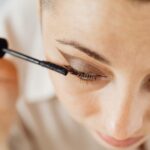Mascara is made from a combination of ingredients like pigments, waxes, oils, preservatives, and stabilizers. It comes in various formulations, including water-based, waterproof, and tubing mascaras, and may contain natural or synthetic ingredients.

Common Ingredients in Mascara
Mascaras are made of a combination of ingredients that help thicken, lengthen, and darken lashes. These ingredients generally include pigments, waxes, oils, preservatives, and stabilizers. Here are some of the most common ingredients found in mascara:
Pigments
Pigments are responsible for providing color to mascara. Common pigments used in mascara include iron oxides, ultramarines, and titanium dioxide. These pigments are generally safe and provide the dark color typically associated with mascara.
Waxes
Waxes help mascaras adhere to lashes and provide a thicker, more voluminous appearance. The most common waxes used in mascaras are beeswax, carnauba wax, and paraffin wax. These waxes help create a smooth, easy-to-apply formula that coats lashes evenly.
Oils
Oils in mascara help to condition and moisturize lashes, as well as create a smooth and emollient texture. Some common oils used in mascara formulations include mineral oil, castor oil, and lanolin oil.
Preservatives
Preservatives are added to mascaras to extend their shelf life and prevent the growth of bacteria and mold. Some common preservatives used in mascara include parabens, phenoxyethanol, and sodium dehydroacetate.
Stabilizers
Stabilizers help maintain the consistency and texture of mascara, ensuring that it remains smooth and easy to apply. Common stabilizers include hydroxyethylcellulose, xanthan gum, and synthetic polymers.
Natural vs. Synthetic Mascara Ingredients
Mascaras can be formulated with natural, synthetic, or a combination of both types of ingredients. Each has its advantages and disadvantages:
Natural Mascara Ingredients
Natural mascaras often contain ingredients derived from plants, minerals, or other natural sources. These mascaras may be more suitable for those with sensitive skin or allergies to synthetic ingredients. Common natural ingredients include beeswax, carnauba wax, plant-derived oils, and natural pigments.
Synthetic Mascara Ingredients
Synthetic mascaras contain ingredients that are man-made or chemically derived. These ingredients can provide longer-lasting wear, more intense color payoff, and better water resistance. Common synthetic ingredients include paraffin wax, synthetic polymers, and silicone-based oils.
It’s essential to keep in mind that natural ingredients are not necessarily safer or better for your skin or lashes than synthetic ones. The safety and effectiveness of a mascara depend on the overall formulation and individual ingredients.
The Role of Pigments in Mascara
Pigments are responsible for providing the color in mascara. The most common pigments used are iron oxides, which are available in various shades, including black, brown, and red. Other pigments used in mascara include:
- Ultramarines: These pigments provide a range of colors, from blue to violet, and can be used in colored mascaras.
- Titanium dioxide: This pigment is often used in combination with other pigments to create a range of colors, and it can also be used in white mascaras to lighten and brighten the lash line.
It’s important to note that some pigments, such as carbon black and chromium oxide greens, have been associated with safety concerns. However, the FDA regulates the use of color additives in cosmetics, ensuring that the pigments used in mascaras are safe for use.
Preservatives and Stabilizers in Mascara
Preservatives and stabilizers play essential roles in maintaining the safety, quality, and performance of mascara. Here’s an overview of their functions:
Preservatives
Preservatives help extend the shelf life of mascara and protect it against bacterial and fungal growth. Since mascara is a water-based product, it can be susceptible to contamination without proper preservation. Common preservatives used in mascara include:
- Parabens: Parabens are a group of synthetic preservatives that have been used in cosmetics for decades. However, some concerns have been raised about their safety, leading to an increase in paraben-free products. It’s important to note that the FDA considers parabens safe for use in cosmetics at the levels commonly used.
- Phenoxyethanol: This is a common alternative to parabens and is considered a safer and less irritating option. It’s effective against a broad range of bacteria and fungi and is often used in combination with other preservatives.
- Sodium dehydroacetate: This preservative is effective against mold and yeast and is often used in mascara formulations.
Stabilizers
Stabilizers are essential for maintaining the consistency, texture, and performance of mascara. They help ensure that the mascara remains smooth, easy to apply, and resistant to clumping or flaking. Some common stabilizers include:
- Hydroxyethylcellulose: This plant-derived stabilizer is used to thicken and stabilize mascara formulations. It helps to create a smooth, even texture and prevents the mascara from becoming too runny or clumpy.
- Xanthan gum: This natural stabilizer is derived from the fermentation of sugars and helps maintain the viscosity of mascara. It’s often used in combination with other stabilizers to improve the overall texture and performance of the product.
- Synthetic polymers: Polymers like acrylates or PVP are used to create a film that adheres to the lashes, providing long-lasting wear and water resistance.
Understanding Mascara Formulations
There are several types of mascara formulations available, each with its benefits and drawbacks. The most common formulations include:
- Water-based: These mascaras are easy to remove and typically provide a more natural look. However, they may not be as long-lasting or water-resistant as other formulations.
- Waterproof: Waterproof mascaras are resistant to water, sweat, and tears, making them ideal for long wear or active lifestyles. They typically contain synthetic polymers and waxes that create a water-resistant film on the lashes. However, they can be more challenging to remove and may require a specialized makeup remover.
- Tubing: Tubing mascaras use a unique polymer formula that coats each lash in a tube-like casing. This provides long-lasting wear and smudge resistance, and the tubes can be easily removed with warm water and gentle pressure.
Waxes and Oils in Mascara
Waxes and oils play a crucial role in mascara formulation, contributing to its texture, application, and conditioning properties. Some common waxes and oils used in mascara include:
Waxes
- Beeswax: Beeswax is a natural wax derived from honeycombs and provides a smooth, easy-to-apply texture. It also has conditioning properties that can help nourish and protect the lashes.
- Carnauba wax: Derived from the leaves of the Brazilian palm tree, carnauba wax is a plant-based alternative to beeswax. It helps create a smooth, glossy finish on the lashes and is often used in vegan and cruelty-free mascaras.
- Paraffin wax: This synthetic wax is derived from petroleum and provides a smooth, even coating on the lashes. It helps create a long-lasting, smudge-resistant finish.
Oils
- Mineral oil: Mineral oil is a synthetic oil derived from petroleum. It has emollient properties that help create a smooth, easy-to-apply texture and can help condition the lashes.
- Castor oil: Castor oil is a plant-derived oil that is often used in mascara formulations for its conditioning and moisturizing properties. It can help promote lash growth and thickness, and it provides a smooth application.
- Lanolin oil: Lanolin oil is derived from sheep’s wool and is known for its moisturizing and emollient properties. It can help soften and condition the lashes while providing a smooth texture for mascara application.
Potential Allergens in Mascara
While mascara is generally safe for most people, some ingredients can cause allergic reactions or irritation in sensitive individuals. Common allergens and irritants in mascara include:
- Fragrance: Some mascaras may contain added fragrances that can cause irritation or allergic reactions in sensitive individuals. Opting for fragrance-free mascaras can help reduce the risk of irritation.
- Parabens: As mentioned earlier, parabens are a group of synthetic preservatives that have been associated with safety concerns. Some people may be sensitive or allergic to parabens, so choosing a paraben-free mascara may be a safer option.
- Propylene glycol: This synthetic ingredient is used as a humectant and solvent in some mascara formulations. It can cause irritation or allergic reactions in some individuals, particularly those with sensitive skin.
If you experience irritation or an allergic reaction to mascara, discontinue use immediately and consult a dermatologist or healthcare professional for guidance.
Key Takeaways
- Mascara is made of a combination of ingredients, including pigments, waxes, oils, preservatives, and stabilizers.
- There are natural and synthetic mascara ingredients, each with their advantages and disadvantages.
- Mascara formulations can vary, with options like water-based, waterproof, and tubing mascaras.
- Some common allergens in mascara include fragrance, parabens, and propylene glycol.
Conclusion
Understanding the ingredients and formulation of mascara can help you make informed choices when selecting the right product for your needs. Whether you prefer natural or synthetic ingredients, it’s essential to be aware of potential allergens and irritants and choose a mascara that suits your skin type and sensitivity.








